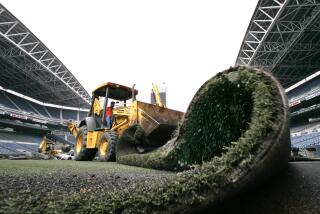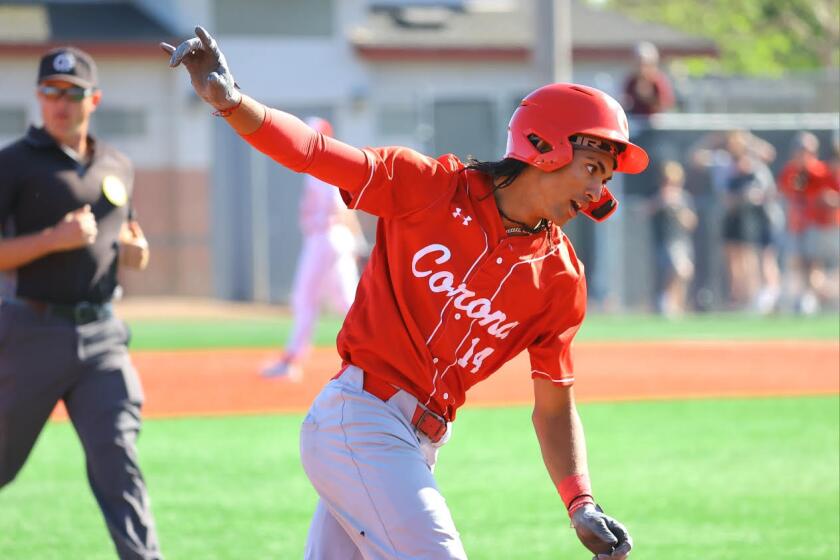A Good Reason to Seek Greener Pastures : Injuries: Current water restrictions could result in safety problems for football players.
- Share via
Stephen T. Cockerham, turf expert at UC Riverside, warns that drought-prompted cutbacks in watering high school football fields could mean increased injuries to players this fall.
“If you’re going to have a football team, you’ve got to have a decent field,” Cockerham said. “The field is part of the safety system. If the field doesn’t get enough water, the potential for increased injuries will be there.”
Cockerham, 52, who heads his school’s turf research program and for several years has experimented with simulated athletic field turf on a 10-acre plot, said high schools should provide football fields with ample water at the expense of lawns, gardens and other areas on campus.
“If they turn the water off, it’s not in the best interest of student-athletes who should not have to worry about the drought when it comes to playing football,” he said.
Cockerham has been the turf consultant to the Los Angeles Coliseum since 1983. The Coliseum, home field of the Raiders and USC, boasts a football field consistently rated among the top five by professional and college teams for playability.
“Football players receive a lot of injuries by the very nature of the game,” Cockerham said. “If schools really care about their football players, school administrators need to pay more attention to the turf under their cleats.”
Santa Barbara had water rationing in effect during the 1990 football season. Satini Puailoa, coach of the football team at San Marcos High, said that two years ago, when the field was in good shape, the team lost one player with injuries for the season and another player for two games.
“But last year we lost guys right and left because the field wasn’t watered properly and wasn’t safe,” Puailoa said. “Fourteen of our players missed at least two games due to ankle, knee and shoulder injuries due to the condition of the field.”
Mike Walsh, coach at San Pedro High, said his field is hard as a rock.
“It’s like falling on concrete, Walsh said. “A couple of hours of spring training and the kids’ knees are hurting. We don’t have sprinklers. In past years, we let the water run all night, soaking the field. Then we let it dry out to get a nice soft field.”
But there is no overnight soaking this year.
“Just look how bad it is,” said assistant coach John Misetich. “It’s a joke. It’s like the Burma Road. We can’t water it, yet we should be watering it for the kids’ sake.”
At Santa Monica High, Coach Ron Guercio said his field is in the worst shape ever.
“We’re cutting back on water, have fewer gardeners to take care of the field because of economic cutbacks,” he said. “If the kids don’t have good footing, they can fall, put up their hands and break a wrist real easy.”
Coach Rob Levy of Belmont High is not so fortunate.
“I have the worst football field in Los Angeles,” he said. “There’s no park nearby and everybody uses the football field. There’s hardly any grass on it now. It will be reseeded, but I’m concerned about how my players will do with the cutback in watering. With a harder surface, the harder the hits the kids will take when they’re tackled.”
Hal Harkness, Director of interscholastic athletics for Los Angeles City Schools, commented: “We are obligated to adhere to the city water regulations. But spring isn’t a time we normally gauge hardness or softness of football fields. We will be replanting (this month).
“We not only face mandate cutbacks in water usage, but cutbacks in gardening and maintenance as well. If we find the fields are not getting enough water, we’ll have to address that problem in the fall.”
Alan Tomiyama, director of operations for custodial and gardening in the Los Angeles City Schools, said the watering issue is not carved in stone.
“If we find that our watering practices are going to be a safety factor in football fields, we will review it,” he said. “Safety is a paramount issue and we’re not going to let the football fields deteriorate to the point where abnormal injuries occur.”
David Palmer, who assigns football officials for Los Angeles City Schools, expressed concern about Cockerham’s warning, however.
“It raises some unusual issues,” he said. “It could open a can of worms when you think about liability.”
Cockerham, immediate past president of the National Sports Turf Managers Assn., said that in some parts of the country, lawsuits have been filed by injured players who contended that the fields they played on weren’t safe.
“It’s pretty much a judgment call and how much water can be cut back before entering the danger zone,” Cockerham said.
He is adamant in his thinking, however, that water rationing should not be applied to athletic fields.
At UC Riverside, Cockerham uses a machine he invented, called the Brinkman traffic simulator. It’s named after Dan Brinkman, a mechanic at the school who put it together.
Pulled by a small tractor, the machine has two rollers with cleats that can be adjusted to mimic the wear and tear of professional or amateur football, baseball and soccer. The rollers are connected by chain and sprockets. The combination of cleats, sprocket differential, and weight simulate the three components of sports traffic, shearing action, compaction and wear.
“Each cleat approximates the same amount of pounds per square inch as a 270-pound lineman on his cleats when linemen clash,” said Cockerham, who observed 14 professional football games to determine the worst wear areas, between the 40-yard lines, and recreates that action on the simulator.
“The most important single factor in determining wear tolerance of turf, its resilience and shear strength, is the biomass above the ground,” he said.
He “plays” four football games a week with the traffic simulator at his 10-acre experimental plot, where he has tested 75 grasses, numerous fertilizers and irrigation techniques in an effort to come up with the best cushion for safe play on the football field.
“I’m learning hard scientific facts about the damage done to the turf by football players, how fast the ground gets hard, how fast it loses traction capability, the best grasses and fertilizers to use,” he said.
He noted that in a four-year study of grasses, durable, attractive, pest-free perennial ryegrass varieties now available offer important safety features for athletes.
Bermuda grass is the most popular grass used on Southern California high school football fields, he said. Unfortunately, he added, Bermuda is not a good cool-weather grass because it browns out toward the end of the local football season and doesn’t offer the cushion provided by ryegrass.
More to Read
Get our high school sports newsletter
Prep Rally is devoted to the SoCal high school sports experience, bringing you scores, stories and a behind-the-scenes look at what makes prep sports so popular.
You may occasionally receive promotional content from the Los Angeles Times.






